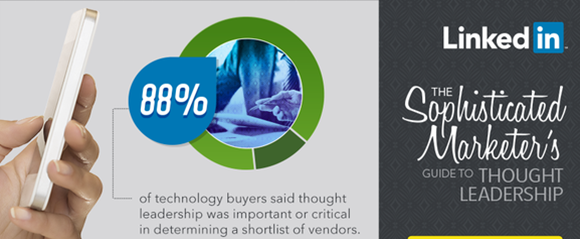According to a LinkedIn study reported in their Sophisticated Marketer’s Guide to Thought Leadership eBook, 88% of IT buyers said that thought leadership was important or critical in determining their short list of vendors. And, if they did this study with other industries, I’m sure they’d find very similar results.
So, why aren’t business, sales, and marketing leaders focused on providing specific thought leadership content that’s relevant to extremely targeted, specific audience? Why are we going for reach and pushing out content (in many cases other people’s content) just to get the like, share, comment and exposure?
Why aren’t we challenging the common social media best practice that the majority of the content you share should not be your own and challenge experts like David Meerman Scott (best-selling author with more than 250,000 books sold worldwide, keynote sales and marketing speaker) who believes that only 10% of the content you share in social media circles should be your own? Why aren’t we challenging Wayne Breitbarth (author of The Power Formula for LinkedIn Success) who believes that for every 10 updates, 6 should be for content you didn’t create?
These best practices automatically put you as a resource rather than an expert who’s putting his or her thoughts out there on a regular basis. LinkedIn gives you the opportunity to go directly to key decision-makers and communicate to them your business value, which should be demonstrated through your thought leadership content. Your business value shouldn’t be that you can curate content that would be relevant to them!
Don’t get me wrong. I love resources–and I’ll connect with someone that can be resourceful to me. But I’m not going to invest in a resource.
The 2nd reason why you are thought of as a resource: You’re simply giving reminders
Viveka von Rosen, author of LinkedIn Marketing in an Hour a Day (and one of the most well-known LinkedIn marketing consultants) talks about how to customize your invitations on LinkedIn. Melonie Dodaro, a contributor to LinkedIn Sales Solutions blog (and the best-selling author of The LinkedIn Code) shares on the LinkedIn publishing platform the “7 messages that you should not send on LinkedIn, including the default message.” In the posts from fellow Social Media Examiner contributor Stephanie Sammons, you’ll find tips about having a professional photo, a strong headline, and a summary written in first person that is prospect-centric.
Isn’t this information that most business, sales and marketing leaders should already know? So the information is simply a reminder. And I thank Viveka, Melonie, and others for being great resources and reminding us what we should be doing.
But does a reminder make you move forward? Do reminders make you question your approach, thoughts, ideas, or actions and open your mind up to alternative options? Doesn’t a thought leader make you think differently–so how is the information you’re providing making you anything other than a resource?
If you look at the articles on my LinkedIn publishing platform, you’ll see I’m challenging LinkedIn and their idea of sophisticated marketing (even though I am featured in their Sophisticated Marketer’s Guide to LinkedIn. I challenge CMOs at top enterprise organizations like Xerox on how they are taking a brand awareness approach to LinkedIn. I challenge how most business, sales, and marketing leaders are failing to communicate real business value to prospects on their profile and how this is causing them to have a worthless LinkedIn profile. Do you notice the difference?
The 3rd reason why you are just a resource: you’re providing “me too” content
In reviewing one of our video production and marketing client’s, I noticed that they are sharing the same types of “later stage” production content that their competitors were creating. For example, here are the types of content that you could find on our client’s blog:
- How to construct your videos around the call-to-action
- Six questions to ask when planning your explainer video
- How long should your videos be–and what should you include
- 3 things to understand in planning an enterprise solutions explainer videos
- Five mistakes B2B organizations make when creating their technology marketing videos
- How to condense your product information and marketing messages into a two-minute (or less) video
You see there was no content to drive demand. There was no content to create an unconsidered need and an unexpected urgency and demand for the company’s services. You see, the company was only basing their content on what customers were saying what their needs were. So they were responding to those known needs with commodity messaging that were very much like the information their competitors were providing. Thus, they were being a resource rather than a thought leader that shows how they can take a vision and turn it into a path to value.
By changing the client’s content and focusing on unconsidered needs–how videos should be used with the actions that sales and marketing has as top priority–our client was able to drive an unexpected urgency. You see, the client was now driving action by going beyond the “me too” content that every other video production, explainer video creation, and video marketing firm was providing.
Thought leaders drive action–so if your content is not driving action, then maybe it’s time that you take a look and see if you’re a thought leader or just resource. Inside the webinar that I hosted with Biznology, I talk more about the content that you should be providing–plus, how you should be going beyond brand awareness to drive demand on LinkedIn.






This sort of in search of get the enhancements made on this special lifestyle and diet, begin your L . a . Shifting the pounds diet solution is a huge procedure into accesing which usually hope.